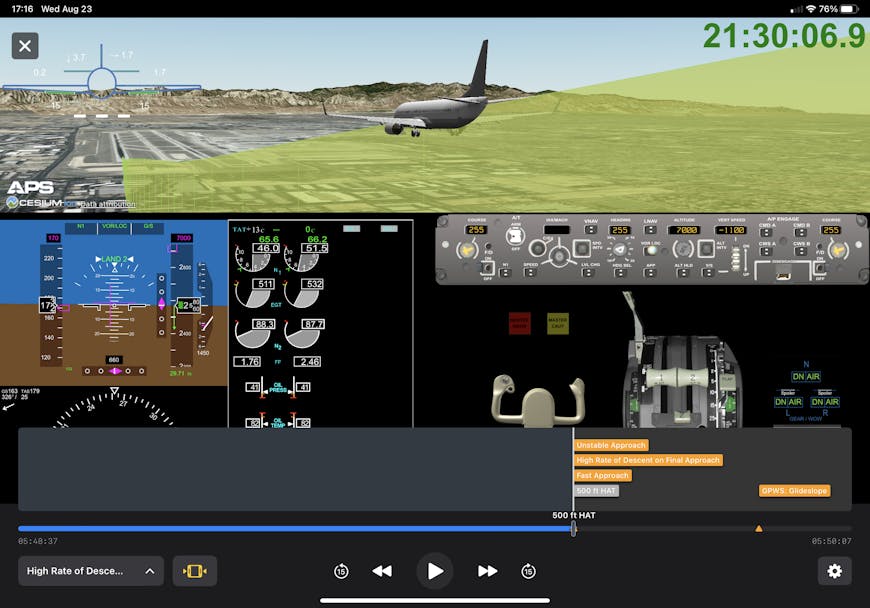GE Aerospace’s FlightPulse Enables Pilots to Review Landings with CesiumJS
Airlines have long collected flight data from multiple sensors on air vehicles, including information on unsafe landings or other procedures at airports. GE Aerospace, Software as a Service's FlightPulse app enables pilots to prepare for upcoming flights and review their final approaches in 3D with an animation module by APS Aerospace Corp., powered by CesiumJS.
Example from FlightPulse demo dataset showing unstable approach into Harry Reid International Airport, Las Vegas, Nevada, USA. App users see terrain and instrumentation in 3D. Courtesy GE Aerospace, Software as a Service.
FlightPulse is an iOS native app first released in 2017 as part of GE Aerospace, Software as a Service's Flight Analytics package for airlines, and 3D animation was introduced in 2022, displaying both terrain and air vehicle instrumentation. The Preflight module enables pilots to prepare for upcoming flights, homing in on specific airports and trajectories, such as holding procedures, and becoming acquainted with approaches they may not have flown before. With the Postflight module, pilots have secure access to their individual flight histories to review their own operations for improvement. Currently, more than 30,000 pilots use the app.
"Animating flights in FlightPulse using the playback functionality powered by APS and Cesium is one of the most compelling features for pilots. In talking with our customers who have deployed it, the results have shown that it drives recurring user engagement and more proactive safety debriefings," said Jonathan Morrell, FlightPulse product manager at GE Aerospace, Software as a Service.
The 3D animation module is the work of a collaboration between GE Aerospace, Software as a Service and APS Aerospace Corp. (previously Applied Informatics and Research Inc.), which has done flight data analysis and flight animation since the 1980s. APS has been using Cesium for years to share and interact with dynamic geospatial data in 3D. For FlightPulse, APS drapes Mapbox 2D imagery over Cesium World Terrain, served as 3D Tiles via Cesium ion, pairing time-series data with precise real-world locations in CesiumJS for easy interpretation and streaming to pilots’ handheld devices. Built on open formats, CesiumJS is designed for robust interoperability and scaling for massive datasets.
“WebGL and standards for 3D on the web are vital,” said JS Theriault, CTO of APS and principal technical point of contact for GE’s Cesium apps. “The Cesium component gives you the entire world. We’re a small company and could not afford to create all of this on our own.”

For 3D animations in the Postflight module, pilots see only their own flights, including those that may have triggered a safety event, such as descent speed above airline guidelines. Courtesy GE Aerospace, Software as a Service.
With 3D animation in FlightPulse, pilots are encouraged to take an active role in flight safety and fuel efficiency.
Cesium ion includes access to curated global 3D content. Sign up for a Cesium ion account to combine these assets with your own and create an interactive aerospace app.